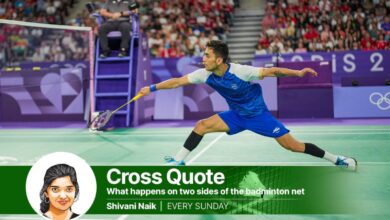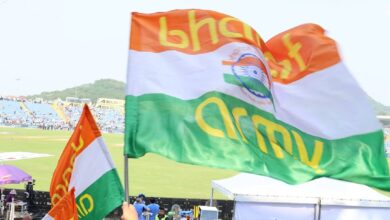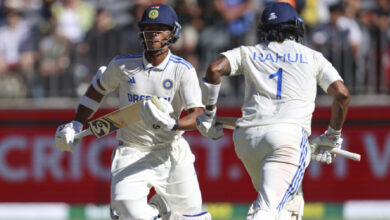Vijay Amritraj, the OG sporting superstar and king of Indian tennis’ good times. Now a Hall of Famer. | Tennis News

It might have been the only time Amitabh Bachchan was maken for Vijay, and the confusion wasn’t because of the name he went in many of his iconic films.Some time back, sitting in the stands at the US Open, Hindi cinema’s biggest star was mobbed a bunch of Indian autograph seekers at New York’s final tennis Grand Slam. Intrigued the sudden commotion, a small group of seasoned American tennis watchers too joined the queue. They would turn to Amitabh and ask: “You are Vijay Amritraj, aren’t you? We have seen you play.”
At the start of the 70s, for one part of the globe India was Bachchan; for the rest, possibly the more influential tennis-playing West, it was Vijay Amritraj. India’s first professional athlete and country’s dinguished ambassador abroad got tennis immortality this week. A player with no Grand Slams and highest ranking of World No.18, Vijay was this year’s popular entry into the International Tennis Hall of Fame.
Hidden in the official announcement’s heart-felt praise was the reasons for the choice. “The Hall of Fame is not just about counting trophies … These aren’t just great players, these are the greatest players. The most impactful contributors our sport has ever known … This is not the end of an international career, it is the beginning of tennis immortality for those incredible champions who were, who are and who forever will be the sport of tennis.”
Tennis Legend Vijay Amritraj during Idea Exchange at The Indian Express, Mumbai. (Express photo Nirmal Harindran)
For the generations that feel that tennis started with Federer vs Nadal at the turn of the century and no Indian in the singles draw is a tennis norm, the Vijay story needs to be retold. Google can get you statics but not the stature of the one-of-a-kind Indian sporting stalwart who enhanced the country’s image abroad.
Much before “Incredible India” became a brand and “a brave new India” an aspirational political slogan; Vijay, both on and off the court, was articulating to the world that there was more to his country than the usual snake charmers, yogis and Bleeding Madras T-shirts stereotyping.
Far ahead of the era he grew up in, Vijay was the crowd-puller at Slams and a magnet at after-match parties of the rich and famous. He, and his brothers Anand and Ashok, didn’t need to be a yogi or play sitar to get acceptance in the western world. Vijay played their sport and played it way better than them. He spoke their language and was far more eloquent then them.
As a Top 20 player he could hold his own against the likes of Laver, Smith, McEnroe, Connors. His charm, wit and intellect would get him entry into elite circles. As a 6″3′ broad-shouldered athlete, Vijay wasn’t the archetypal average Indian of those times. He and his dreams were bigger than most in pre-liberalisation 70s India.
When travelling the world, Vijay didn’t carry any third-world baggage. He was soft spoken but he did raise his voice if forced. He was a true global citizen but remained fiercely patriotic. He was an asset to his sport but he remained committed to his David Cup duties. He also did his bit to make the tennis-loving nation, a tennis-playing country.
For a sickly child born with cystic fibrosis, potentially a fatal lung ailment that needs constant hospital visits, Vijay turned out to be a spectacular over-achiever. He took up tennis since the doctor wanted him to pursue an out-door sport.
Vijay Amritraj in action. (Express Archive)
With barely a few pounds in their pockets, he and his brother Anand would travel to England. It was during a pre-Wimbledon tournament in Beckenham, Vijay would spot his hero – the maverick tennis guru Pancho Gonzales. The lanky boy from Chennai would show courage to approach him. The initiative would result in a hitting session. Pancho was impressed, he invited the brothers to US tennis’ sanctum sanctorum of Sin City, Hotel Caesars at Las Vegas.
Caesars had a tennis tradition and hosted a famous big prize-money tournament. It had dractions too. Vijay mentions them in his book: “It was newest, gaudiest and most luxurious place but a tennis place too … It was build to take your money and lead you off the straight and the narrow. … There was a restaurant with Julius Caesar’s statue where toga-clad waitresses with legs that go on forever slither up behind you and massage your neck after a long hard dinner.” This would be the unlikely place where Pancho did the game changing tweak to Vijay’s game. He added more power and sting to his second serve. You didn’t have to be just fittest to survive on the tennis circuit, you also had to be smartest.
Long before words like “hustle” and “jugaad” started getting used Corporate India, the Amritrajs had aced them. On a frugal budget, the brothers had a hand-to-mouth economic model. There was a time, they faced a series of adverse results. “Every Monday I was out of the tournament and had the whole week free, with 5 dollars in my pocket. We literally had to win in the afternoon to be able to eat at night,” he would say.
To avoid going hungry to bed, Vijay came up with a ‘hustle’ that involved betting on Anand’s brilliant chess playing skills. Since the tournaments were at posh clubs, the the big-talker Vijay would take bets from the moneyed members to beat Anand at chess. The back-up plan worked. Now, they could afford to lose at tennis since they were winning at chess.
With time the results changed and America was steadily warming up to the tall, lanky Indian with a tight serve and volley game. While at his peak, Vijay once went on to play at another spectacular hotel frequented white elderly Florida folks. He would wear his Chennai shirts and Kolhapuri chappals to dinner, inviting stares. Opinion would change when Vijay would beat Rod Laver in earlier rounds and Jimmy Connors in the final.
His fluent strokes and charming smile would win hearts. “I won the tournament, and the time I went for dinner in the evening, most of the people were trying to buy chappals to wear,” Vijay would say. But his was no feel-good movie, where sporting success makes barriers to fall and prejudices to disappear and stereotypes to get wiped out.
Later at the US Open, Vijay would defeat Laver again. New York Times would applaud the effort but there was a line from the report – “The incredibly poised and polite dark‐skinned Amritraj” – doesn’t read right in present times. Even revisiting his much talked about role in the Bond movie Octupussy doesn’t feel right. Vijay is shown as a snake charmer and an auto driver. An undercover agent, when he drives Bond through a street during a chase, the film-makers don’t miss a single Indian imagery that is objectionable. There were cows, camels, fire-eaters, sword swallowers, a yogi on a bed of nails, beggars and finally the natives fighting for cash thrown at them a white man.
With time, India’s image would change. That had a lot to do with Bond’s auto-driver on screen who in real life would go to be a Hollywood producer, a broadcasting icon, UN ambassador for peace and now a Hall of Famer.







